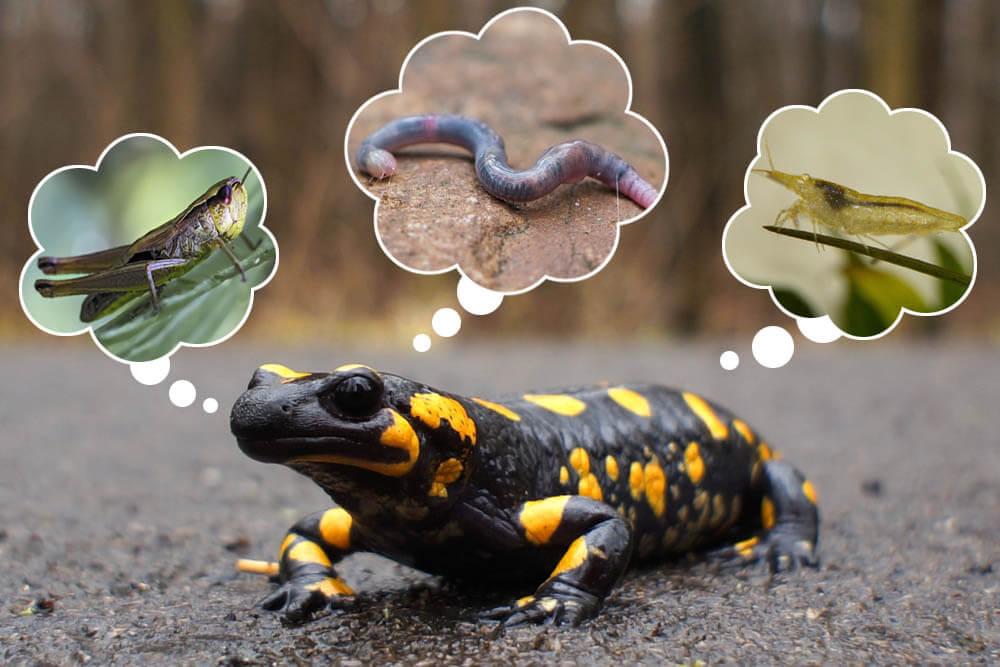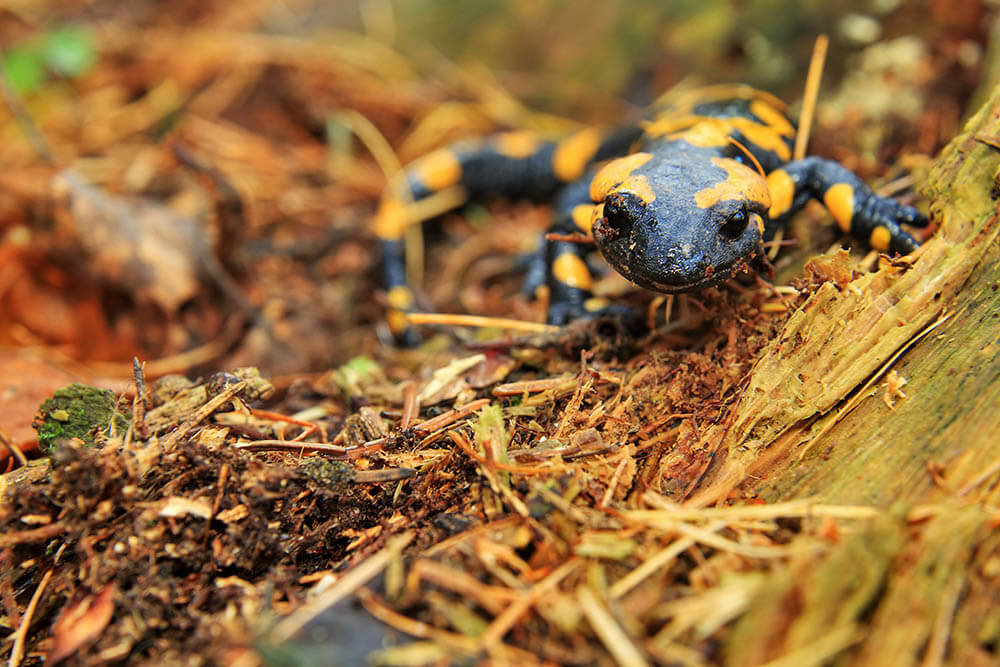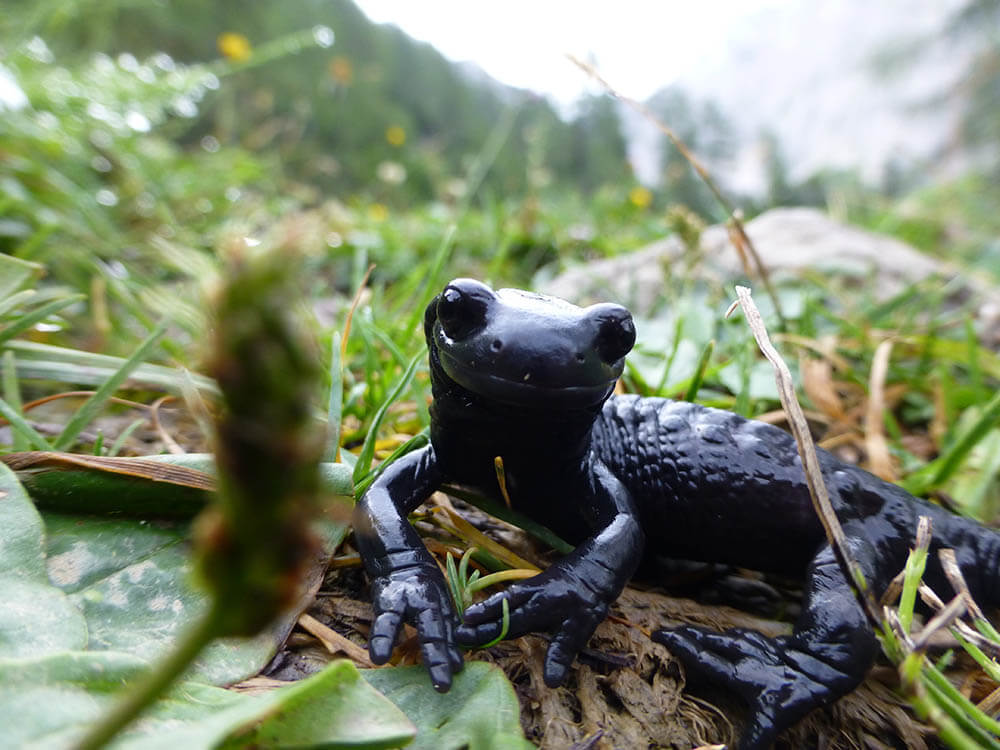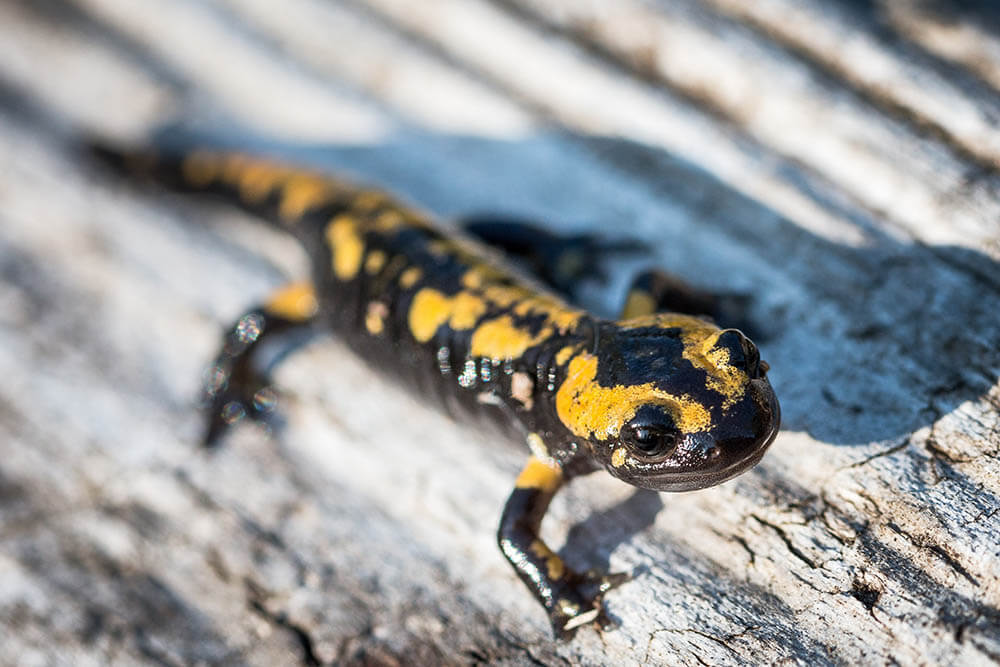Salamanders are lizard-like amphibians that inhabit temperate regions all over the world. In North America, they make popular pets, especially among those who love exotic animals.
Are you considering keeping a salamander? If so, then it’s a good idea to know what these creatures eat not just in captivity but also in their natural habitat. After all, the diet of a pet salamander isn’t too different from a wild salamander’s. More importantly, this knowledge will help you ensure your friend enjoys the best health and a long, happy life.
Before we explore the salamander diet, however, let’s learn a few things about these enigmatic creatures.

Getting to Know the Salamander
Scientists recognize more than 655 salamander species. These creatures come in many shapes, colors, and sizes. The smallest, the pygmy salamander, is around 1.5 inches long, while the largest, the critically endangered Chinese salamander, can grow a whopping 1.8 meters long! The most popular pet salamanders include the axolotl, fire salamander, tiger salamander, marbled salamander, Dunn’s salamander, California newt, Eastern newt, and fire belly newt.
As either semi-aquatic or strictly aquatic, all salamanders are excellent swimmers thanks to their smooth, slippery bodies.
Salamanders take around 2 to 3 years to reach full maturity. Their age typically determines where they live. Young salamanders, for instance, stay in the water 24/7, which is made possible thanks to gills. As they grow older, those gills vanish, and they start spending time both in the water and on land.
Age also influences what salamanders eat. These amphibians are carnivorous – they feed on meat and only meat. Because young salamanders are strictly aquatic, however, they consume aquatic organisms only. When they’re old enough to go on land, they start hunting terrestrial critters, too..
Salamanders typically prey on slow-moving animals such as snails, slugs, and worms. Some larger types consume insects, tiny crustaceans, and fish. Others prefer mice, frogs, and even other kinds of salamanders.
With all that in mind, it’s time to explore what’s on the salamander’s menu.

The Wild Salamander’s Diet
As discussed above, what a salamander feeds on depends on its age. We’ll therefore be categorizing the salamander diet by age.
What immature salamanders eat
Young salamanders are strictly aquatic. Thus, they only ingest aquatic critters.
Newly born salamanders consume microscopic crustaceans such as:
Juvenile salamanders consume the following creatures:
- Brine shrimp
- Daphnias
- Mosquito larvae
- Tubifex worms
What mature salamanders eat
Once a salamander is old enough to be capable of survival both in the water and on land, its diet shifts to include prey such as:
- Ants
- Beetles
- Buffalo worms
- Crickets
- Earthworms
- Flies
- Fruit flies
- Maggots
- Mysis
- Snails
- Springtails
- Ticks
It’s important to remember, however, that salamanders are opportunistic and voracious eaters; they consume almost any living thing they come across as long as it’s not too big to fit in their mouth. This means they enjoy diverse diets that consist of all sorts of larvae and insects. Occasionally, they even snack on small rodents and other types of salamanders!

The Pet Salamander’s Diet
Because the captive salamander has the same nutritional requirements as the wild salamander, it’s a good idea to give your pet a diet that replicates the wild salamander’s.
However, this doesn’t mean you should visit swamps or ponds and start catching insects, worms, crustaceans, and the like for your pet. In fact, prey harvested from the wild may be infected with parasites and diseases that can harm your diminutive friend. Instead, you should go to a pet store or bait shop and buy food for your salamander; many of what these creatures naturally consume can be found in such establishments, anyway.
Everything we discussed about the wild salamander diet applies to the pet salamander’s. So you should also feed newly born salamanders daphnias, while you should give juvenile salamanders brine shrimp, daphnias, and tubifex worms.
Once your salamander reaches adulthood, feed it the following prey:
- Bloodworms
- Crickets
- Dubia roaches (small)
- Earthworms
- Fish (small)
- Minnows
- Nightcrawlers
- Pinkie mice (dead baby mice)
- Snails (small)
- Waxworms
Keep in mind that your salamander’s specific species will also influence what it eats. A tiny salamander, for example, likely won’t want anything to do with a snail that’s twice its size.
It’s generally much better to feed your pet gut-loaded live food. These are living animals that have recently been fed a diet high in calcium and other essential nutrients.
Regarding supplements
Because it’s obvious that wild salamanders don’t have access to supplements, many pet owners think they don’t need to feed their pets supplemental vitamins and minerals. However, such supplements can significantly boost the health of our amphibious pets and ensure they enjoy a long, happy life.
We therefore recommend giving your salamander calcium and multivitamin supplements once or twice per week.
The mineral calcium is especially important to amphibians, as it plays a crucial role in the development and maintenance of strong, healthy bones. A calcium deficiency can result in irreversible deformities, bones that break easily, and even death. So coat your salamander’s food in calcium powder once in a while!
Seek veterinary advice
What’s the best way to determine the most appropriate foods for your pet salamander? Ask a veterinarian who specializes in exotic pet care!
A vet will thoroughly examine your pet, allowing them to figure out what specific foods it will benefit from the most. Don’t forget to listen to all the advice the vet offers and follow their instructions closely!

Tips On How to Feed Your Salamander
While feeding a pet salamander isn’t complicated, there are a few things you should keep in mind to ensure the process is as smooth as possible.
Use tweezers to grab live food
Salamanders generally prefer live food. To prevent a living animal from getting away, use tweezers or forceps to grip it on one end, a leg, or its tail. This grip must be firm, but not so strong that you end up crushing or killing the food.
Offer the food to your salamander
While keeping a firm grip on the live food, bring said food closer to your pet until it’s right in front of its face. Make sure your salamander has a clear view of the food.
When a salamander is ready to devour its food, it strikes at an incredible speed. Therefore, you should be ready to release the prey once your pet wants to consume it. It’ll help to loosen your grip on the food a bit so that your salamander can snatch it from the tweezer without any issues. If you have excellent reaction time, you can even release your hold on the food the moment your pet lunges at it.
Feed your salamander at night
Salamanders are nocturnal, meaning they’re most active at night. For this reason, you should feed your pet when the sun’s already gone down, preferably before you go to bed.
Don’t feed your salamander non-meat items
Salamanders are strictly carnivorous, so they won’t ingest fruits and vegetables. Their digestive system can’t handle plant matter, anyway. Therefore, all the food you offer your pet must be animal matter.
Any fruit or vegetable you give your amphibious friend will only end up getting ignored. If this food spoils, it’ll expose the poor thing to various harmful microorganisms. Stale or rotten food may also attract disease-carrying insects into your salamander’s enclosure. Both concerns will leave your pet vulnerable to a range of health problems. For all these reasons, never give your pet plant-based foods.
Adjust your salamander’s feeding schedule accordingly
Not all salamanders are the same; some eat every day, while others eat less often.
You can try offering your salamander food daily. If this works for it, then great – in a single feeding session, offer your pet as much food as it’s willing to ingest, then remove any uneaten food to keep its enclosure clean. However, if it doesn’t take to eating every day, then consider giving it food every two days.
What if your pet still refuses to eat? Consider the possibility that it may be because it finds its environment uncomfortable. The solution to this issue is to transfer your salamander into another enclosure and thoroughly clean the original one before returning it to said original enclosure. Alternatively, you can get your pet a new, better enclosure.
We also recommend seeking veterinary assistance. If your salamander won’t consume anything, it may be in pain due to illness, disease, or injury, so a vet may have to treat it to restore its appetite.

Conclusion
Salamanders are carnivorous amphibians that consume a range of tiny animals. What they dine on is largely dependent on their age. For instance, young salamanders are aquatic and therefore eat small aquatic creatures like daphnias and brine shrimp. Fully grown salamanders can live both in the water and on land, and can thus devour various insects, worms, fish, and gastropods. Some salamander species even feed on tiny rodents and other types of salamanders.
If you’re the owner of a pet salamander, know that this creature should observe a diet that’s a close replication of what it would eat in its natural habitat. Thankfully, many of the creatures these amphibians consume are available for purchase at pet stores and bait shops. Give your pet supplements, as well, as these can enhance its health and guarantee it lives a long, happy life.
